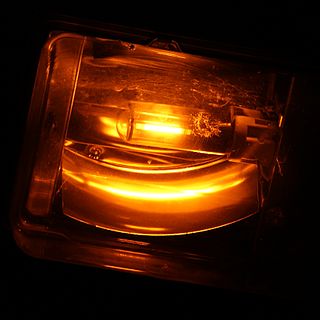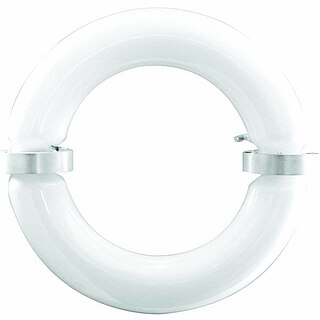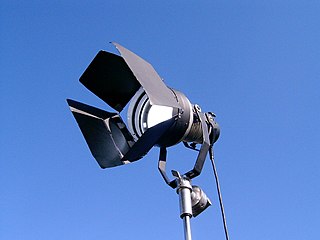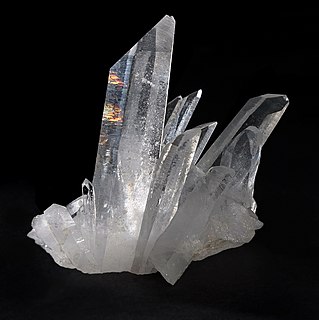
An electric light is a device that produces visible light from electric current. It is the most common form of artificial lighting and is essential to modern society, providing interior lighting for buildings and exterior light for evening and nighttime activities. In technical usage, a replaceable component that produces light from electricity is called a lamp. Lamps are commonly called light bulbs; for example, the incandescent light bulb. Lamps usually have a base made of ceramic, metal, glass or plastic, which secures the lamp in the socket of a light fixture. The electrical connection to the socket may be made with a screw-thread base, two metal pins, two metal caps or a bayonet cap.

A flashlight is a portable hand-held electric light. The source of the light is usually an incandescent light bulb (lamp) or light-emitting diode (LED). A typical flashlight consists of the light source mounted in a reflector, a transparent cover to protect the light source and reflector, a battery, and a switch. These are supported and protected by a case.

A sodium-vapor lamp is a gas-discharge lamp that uses sodium in an excited state to produce light at a characteristic wavelength near 589 nm.
Hydrargyrum quartz iodide (HQI) is a trademark name of Osram's brand of metal halide lamps made for general floodlighting, arena floodlighting, shop and commercial and industrial lighting. Hydrargyrum is the Latin name for the element mercury. When heated, mercury vapour is created inside the lamp, and deposited when it cools.

A plasma globe or plasma lamp is a clear glass container filled with a mixture of various noble gases with a high-voltage electrode in the center of the container.

High-intensity discharge lamps are a type of electrical gas-discharge lamp which produces light by means of an electric arc between tungsten electrodes housed inside a translucent or transparent fused quartz or fused alumina arc tube. This tube is filled with noble gas and often also contains suitable metal or metal salts. The noble gas enables the arc's initial strike. Once the arc is started, it heats and evaporates the metallic admixture. Its presence in the arc plasma greatly increases the intensity of visible light produced by the arc for a given power input, as the metals have many emission spectral lines in the visible part of the spectrum. High-intensity discharge lamps are a type of arc lamp.

A mercury-vapor lamp is a gas discharge lamp that uses an electric arc through vaporized mercury to produce light. The arc discharge is generally confined to a small fused quartz arc tube mounted within a larger borosilicate glass bulb. The outer bulb may be clear or coated with a phosphor; in either case, the outer bulb provides thermal insulation, protection from the ultraviolet radiation the light produces, and a convenient mounting for the fused quartz arc tube.

A metal-halide lamp is an electrical lamp that produces light by an electric arc through a gaseous mixture of vaporized mercury and metal halides. It is a type of high-intensity discharge (HID) gas discharge lamp. Developed in the 1960s, they are similar to mercury vapor lamps, but contain additional metal halide compounds in the quartz arc tube, which improve the efficiency and color rendition of the light.
The most common metal halide compound used is sodium iodide. Once the arc tube reaches its running temperature, the sodium dissociates from the iodine, adding orange and reds to the lamp's spectrum from the sodium D line as the metal ionizes.
As a result, metal-halide lamps have high luminous efficacy of around 75–100 lumens per watt, which is about twice that of mercury vapor lights and 3 to 5 times that of incandescent lights and produce an intense white light. Lamp life is 6,000 to 15,000 hours. As one of the most efficient sources of high CRI white light, metal halides as of 2005 were the fastest growing segment of the lighting industry. They are used for wide area overhead lighting of commercial, industrial, and public spaces, such as parking lots, sports arenas, factories, and retail stores, as well as residential security lighting and automotive headlamps.

The internal electrodeless lamp or induction lamp is a gas discharge lamp in which an electric or magnetic field transfers the power required to generate light from outside the lamp envelope to the gas inside. This is in contrast to a typical gas discharge lamp that uses internal electrodes connected to the power supply by conductors that pass through the lamp envelope. Eliminating the internal electrodes provides two advantages:

Hydrargyrum medium-arc iodide, or HMI, is the trademark name of Osram's brand of metal-halide gas discharge medium arc-length lamp, made specifically for film and entertainment applications. Hydrargyrum comes from the Greek name for the element mercury.

A xenon arc lamp is a highly specialized type of gas discharge lamp, an electric light that produces light by passing electricity through ionized xenon gas at high pressure. It produces a bright white light that closely mimics natural sunlight, which extends its applications into the film, and daylight simulation industries. Xenon arc lamps are used in movie projectors in theaters, in searchlights, and for, as mentioned previously, specialized uses in industry and research to simulate sunlight, often for product testing.

The sulfur lamp is a highly efficient full-spectrum electrodeless lighting system whose light is generated by sulfur plasma that has been excited by microwave radiation. They are a particular type of plasma lamp, and one of the most modern. The technology was developed in the early 1990s, but, although it appeared initially to be very promising, sulfur lighting was a commercial failure by the late 1990s. Since 2005, lamps are again being manufactured for commercial use.

The ceramic discharge metal-halide (CDM) lamp, often referred to as Ceramic Metal Halide lamp (CMH) is a source of light that is a type of metal-halide lamp which is 10-20% more efficient than the traditional quartz metal halide and produces a superior color rendition.

Gas-discharge lamps are a family of artificial light sources that generate light by sending an electric discharge through an ionized gas, a plasma. Typically, such lamps use a noble gas or a mixture of these gases. Some include additional substances, like mercury, sodium, and metal halides, which are vaporized during startup to become part of the gas mixture. In operation, some of the electrons are forced to leave the atoms of the gas near the anode by the electric field applied between the two electrodes, leaving these atoms positively ionized. The free electrons thus released flowing onto the anode, while the cations thus formed are accelerated by the electric field and flow towards the cathode. Typically, after traveling a very short distance, the ions collide with neutral gas atoms, which transfer their electrons to the ions. The atoms, having lost an electron during the collisions, ionize and speed toward the cathode while the ions, having gained an electron during the collisions, return to a lower energy state while releasing energy in the form of photons. Light of a characteristic frequency is thus emitted. In this way, electrons are relayed through the gas from the cathode to the anode. The color of the light produced depends on the emission spectra of the atoms making up the gas, as well as the pressure of the gas, current density, and other variables. Gas discharge lamps can produce a wide range of colors. Some lamps produce ultraviolet radiation which is converted to visible light by a fluorescent coating on the inside of the lamp's glass surface. The fluorescent lamp is perhaps the best known gas-discharge lamp.
A grow light or plant light is an artificial light source, generally an electric light, designed to stimulate plant growth by emitting a light appropriate for photosynthesis. Grow lights are used in applications where there is either no naturally occurring light, or where supplemental light is required. For example, in the winter months when the available hours of daylight may be insufficient for the desired plant growth, lights are used to extend the time the plants receive light. If plants do not receive enough light, they will grow long and spindly.

The SeaChanger Color Engine is an electro-mechanical device that is used to control light color in entertainment-industry lighting applications. The unit employs four overlapped color filter wheels, inserted into a light beam near its source, to produce colored light. This is in contrast to color scrollers, which insert color filter ribbons into a light beam. The color engine, which was released by Ocean Thin Films in 2005, is designed to fit into the Source Four lighting instrument made by Electronic Theatre Controls.
Ceravision is a privately owned lighting company based in Milton Keynes, UK. Ceravision is the inventor of High Efficiency Plasma (HEP) lighting technology, a new and unique genre of electrodeless lamps, driven by radio frequency (RF) and particularly suited to medium and high power commercial applications.

A crackle tube is a type of plasma lamp that is used most commonly in museums, night clubs, movie sets, and other applications where its appearance may be appealing for entertainment. Such a device consists of a double walled glass tube with a hollow center. The cavity between the inner and outer glass tubes is filled with thousands of small phosphor coated glass beads. A 5–14 kV transformer produces a low power gas discharge in the bead filled cavity, producing filaments of light that simulate lightning. Crackle tubes get their name not because of the sound they produce but rather because of the appearance of their internal behavior. The "lightning" is forced around and in between the phosphor-coated glass beads, due to the beads' dielectric nature. In so doing, the phosphor is excited by the electrical energy and fluoresces producing visible light. Like plasma globes, crackle tubes respond to touch; the filaments appear to be "attracted" toward the point of contact and usually become more luminous (brighter) as the electricity is grounded. The tubes are also filled with a noble gas like neon, argon, or xenon which acts as the electron transfer medium of the cavity. The gas is typically below atmospheric pressure.
Luxim is a privately owned clean tech company based in Sunnyvale, California, which was founded in 2000.
Plasma lamps are a type of gas discharge lamp energized by radio frequency (RF) power. They are distinct from the novelty plasma lamps that were popular in the 1980s.















